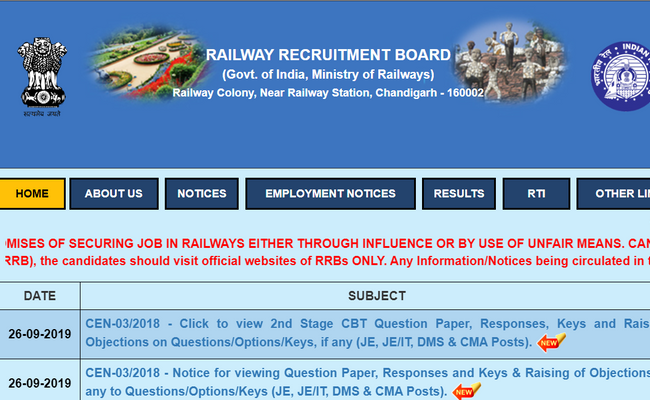In this article, we have provided the mock test for the General Science Section of RRB/RRC Group D 2019 computer-based test 1 exam. RRB is soon going to announce the exam dates and admit card for RRB/RRC Group D 2019 level 1 exam. So the candidates are asked to start practicing the mock tests for the exam.
RRB/RRC Group D 2019 Level 1 General Science Mock Test with Answers:
| Serial no | Questions | Options | Answer |
| 1. | Japanese Encephalitis is spread by | A). contaminated water,
B). Air, C). Dog Bite, D). Mosquito |
D |
| 2. | The characteristic feature of the virus | A). it multiplies only on dead animals,
B). It multiplies only on hosts, C). It lacks Chlorophyll, D). it is made up of fats |
B |
| 3. | The bacterial conversion of nitrogen into nitrogen compounds is called | A). Nitrogenation,
B). Nitrogen Fixation, C). Fertilization, D). None |
A |
| 4. | A body is dropped from a certain height above the ground. When it is halfway down, it posses | A). only kinetic energy,
B). only potential energy, C). both Kinetic and Potential Energy D). Neither kinetic nor potential |
C |
| 5. | An ant can see the objects all around it due to the presence of what? | A). simple eyes,
B). eyes over its head, C). well developed eyes, D). Compound eyes |
B |
| 6. | It is six months long day in the northern polar region and 6 months long night in the southern polar region because | A). a revolution of the earth,
B). earth is inclined towards its orbital plane, C). rotation of the earth, D). none |
B |
| 7. | A sudden fall in the barometric reading indicates what? | A). rain,
B). storm, C). Hot weather, D). Extreme cold
|
B |
| 8. | Which one of the following is an enzyme? | A). glucagon,
B). insulin, C). somatropin D). trypsin |
D |
| 9. | Which of the following is not a physical change? | A). dissolution of oxygen in the water
B). dissolution of carbon dioxide in water, C). dissolution of soil in water D). none |
C |
| 10. | Among the following which is the only snake that builds a nest? | A). viper,
B). krait, C).phython, D). king cobra |
D |
| 11. | Which of the following minerals does not contain oxygen? | A). silicates,
B).carbonates, C).pyrites D). none |
C |
| 12. | Parsec is the unit of measurement of | A). the density of stars,
B). astronomical distance C).brightness of heavenly bodies D). orbital velocity of giant stars |
B |
| 13. | Which of the following disease is caused by the bite of a mad dog? | A). hydroceptecemia
B). hydrocephalus C). hydrophobia, D). none |
C |
| 14. | As compared to pure water, a body in salty water will? | A). sink more
B). sink less C). remain the same D).depends on the way the body is immersed |
A |
| 15. | Which of the following is a colloidal solution | A). vinegar
B). paint C). muddy water D). sugar solution |
B |
| 16. | Which of the following is attracted by a magnet? | A). Sulphur,
B). iron fillings C).iron sulphide D). none |
B |
| 17. | A mixture of and salt can be separated by | A). sublimation
B).sieving C).dissolving saltwater and then filtration D).dissolving salt in water and then distillation |
D |
| 18. | The conversion of a solid directly into vapour is called | A). evaporation
B).condensation C).vaporisation D).sublimation |
D |
| 19. | The common Alum is | A).potassium alum
B).sodium alum C).ferro alum D).chrome alum |
A |
| 20. | The longest cell in the human body is | A). Skeletal cells
B). RBC C).nerve cells D). WBC |
C |
| 21. | Group of cells having a common origin and performing similar functions is called | A). tissues
B).organs C).organ system D).none |
A |
| 22. | The acid present in the stomach which helps in the digestion of food is | A).nitric acid
B).sulphuric acid C).hydrogen chloride D).none |
C |
| 23. | Which pair is not correctly matched | A). pisciculture- fish
B). sericulture – earthworm C).green revolution – agriculture D). white revolution -milk |
B |
| 24. | If the mass of a solid is doubled, its density | A). becomes 2 times
B). becomes half C). remains unchanged D). becomes 4 times |
A |
| 25. | The Fluid part of the blood after removal of corpuscles is called | A). vaccine
B). lymph C).serum D).plasma |
B |
RRB/RRC GROUP D Level-1 2019
- Download previous year papers of the RRB/RRC Group D level 1 exam.
- Practice RRB Group D Level 1 exam 2019 mathematics mock test with answers.
- Practice RRB Group D Level 1 exam 2019 reasoning mock test with answers.
- Know the RRB/RRC Group D level 1 posts 2019 exam pattern and syllabus.
- Get the best books for the RRB Group D level 1 exam 2019 exam preparation recommended by the expert.
- Click here to know the eligibility criteria for RRB/RRC level 1 exam posts recruitment 2019.
Stay connected with fellow students on PaGaLGuY for RRB Recruitment 2019
